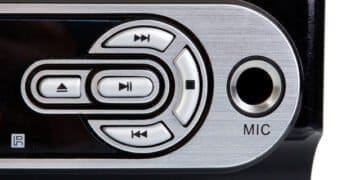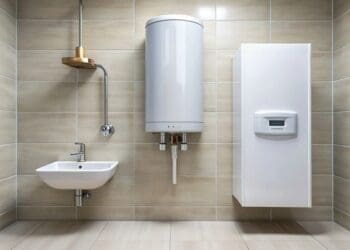With the advancement of cloud technology, commercial keyless entry systems are growing in popularity for securing offices and commercial buildings.
As modern businesses migrate to cloud access control, end-users frictionlessly access secured spaces with mobile devices, granting business owners enhanced control and security.
Keyless entry systems offer convenience, flexibility, audit trail capabilities, and integration possibilities, making them a compelling access control choice.
This guide discusses the different types of keyless entry systems businesses can utilize, such as keypads, key fobs, mobile access control, biometric access systems, and smart locks.
It explores the main benefits of implementing keyless access control solutions like enhanced security, scalability, and remote management capabilities for commercial facilities.
Keypad Locks

A commercial keypad door lock is a type of keyless lock that allows you to control which tenants and staff can enter a building or room. These locks have a numerical keypad (or touchscreen interface with numbers) in place of traditional keyholes.
Keypad Lock Features
Components of commercial keypad door locks include:
- Keypad: The keypad replaces the traditional key-and-lock system. Instead, tenants enter a PIN code to gain access.
- Deadbolt unlocking mechanism: When someone enters an authorized PIN code, the unlocking mechanism physically moves or releases the lock, enabling the user to open the door.
- Control panel: Known as the brain of the system, the control panel stores all its data, including tenant information and authorized PIN codes. The panel either lives on-site or on a cloud-based server.
Many commercial keypad door locks are designed with weather-resistant materials and durable construction to accommodate outdoor use in various environments, including commercial buildings, business establishments, warehouses, and residential properties.
Keypad Lock Benefits
In commercial properties, keypad door locks are installed at individual office suites, custodial closets, supply rooms, office amenity spaces, and restrooms. You can assign authorized users PIN codes that they use to gain access to specific areas within a commercial property.
Commercial door locks with keypads empower you to keep certain rooms locked while ensuring convenient access for authorized tenants and visitors.
Additionally, some commercial digital door lock keypads can only be programmed to accept one PIN code credential, while others allow each tenant to set their own personal codes.
- Keypad locks are just as safe as key locks. Tenants are less likely to be locked out due to a lost or forgotten key, and their keys are less likely to be stolen by criminals.
- Keypad door locks often operate independently of power sources in your building, so they’re battery-powered. Since commercial keypad door locks use very little energy, their batteries typically last a long time.
Keypad Lock Installation
Commercial keypad door locks are relatively easy to install. Installation involves replacing your doorknob and possibly the lock. Factoring in the lock’s price, the installation will cost between $600 and $1,200 per door.
For those who love smart technology, many keypad systems can be easily integrated with other security measures. You can connect your locks to alarm systems, CCTV, and even smart building management systems for a comprehensive security solution.
Key Fob Systems

Key fob systems provide businesses with top-notch security and smooth entry and exit for authorized personnel. These systems allow businesses to grant or deny access to specific areas of their premises, monitor access to sensitive areas, restrict unauthorized access, and record the entry and exit of employees.
Key Fob System Features
In essence, a key fob door entry system is an electronic access control mechanism that uses a small, portable electronic device often called a key fob to grant or deny building entry to authorized users.
Key fobs are typically a similar size to traditional keyrings but provide advantages such as no need to fumble with keys – just wave or tap the fob near the reader, greater security since fob codes can be easily changed or disabled, and improved tracking and auditing of door access.
There are different types of key fobs:
- Proximity Key Fobs: These handy devices work on Radio Frequency Identification (RFID) technology. All you need to do is wave or tap the fob near a corresponding reader, and voilà – the door unlocks! They are effortlessly secure as there’s no need to remove them from your pocket or bag, and highly customizable as the access range can be adjusted based on your needs.
- Smart Key Fobs: These cutting-edge devices rely on Bluetooth Low Energy (BLE) or Near Field Communication (NFC) technology, offering even more convenience and extra perks like mobile app integration for managing access through smartphones and two-factor authentication for enhanced security.
- Biometric Key Fobs: For top-notch protection, biometric key fobs incorporate fingerprint scanning technology in addition to the traditional keyless access control system granted by the fob, restricting access to authorized individuals only and providing more insight into the exact person entering the premises.
- Universal Key Fobs: These nifty gadgets can be programmed to gain access to multiple systems and doors, lessening the load of juggling multiple fobs and simplifying administration by saving time and effort in managing access rights.
Key Fob System Benefits
Key fob systems offer several benefits for businesses, such as improved security, efficient access management, time and cost savings, and enhanced user experience.
Implementing a key fob entry system for your business brings many advantages, including enhanced security as key fobs are harder to duplicate or steal, convenience as authorized users only need a key fob for entry, customizable access by programming key fobs for varying levels of access, easy monitoring and auditing of entry activity, cost-effectiveness in the long run, and reduced risk of lockouts as key fobs can easily be deactivated and replaced.
Key Fob System Management
In today’s fast-paced business world, managing multiple locations with a single key fob system is vital. A good key fob system should have the following essential features:
- Centralized Management: Ability to manage access for all locations from a central point.
- Cloud-based Technology: Cloud-based systems allow remote management and updates.
- Scalability: The system should be scalable to accommodate business growth.
- Mobile Application Support: Mobile apps for convenient management and user access.
- Integration with Other Security Systems: Compatibility with existing security equipment like cameras and alarms.
When selecting a key fob system, look for user-friendly interfaces with intuitive software for managing access levels and fobs, and easy-to-navigate controls for users. The system should also offer robust access control features like customizable access levels for different areas, time-based access control, and the ability to enable or disable fobs remotely.
Comprehensive monitoring and reporting capabilities, such as detailed access logs, real-time monitoring, and customizable reporting options, are also essential. Finally, ensure seamless integration with existing infrastructure, compatibility with other access control methods, and a scalable architecture for long-term growth.
Mobile Access Control

Mobile Access Features
Mobile access control refers to using mobile devices such as smartphones, tablets, and smartwatches as a tenant’s credential to allow them to open doors. Tenants can authenticate their identity on their smartphones with biometrics like fingerprint and face recognition, swiping or tapping in a mobile app, or entering a passcode.
Entering a property through a smartphone app makes access control a seamless process for both tenants and property staff. Mobile access control can also be touchless since users can open doors without touching any surfaces besides their phones.
Mobile access control systems work by enabling communication between the mobile access control reader on the door and credential info stored on tenants’ smartphones. There are three main ways to enable mobile access: WiFi, Bluetooth, and Near-field communication (NFC).
Mobile Access Benefits
Mobile solutions allow users to manage access permissions in real-time. Owners can instantly grant or revoke access remotely, ensuring that only authorized individuals can enter specific areas.
For users who have access to the building via a mobile app, two-factor authentication (2FA) can add an extra layer of security since users must provide both their mobile device and a unique PIN or biometric data to gain access.
Mobile access eliminates the need for physical keys or access cards. Users can simply use their smartphones to unlock doors, gates, or elevators. Owners and tenants can grant temporary access to contractors, delivery personnel, or visitors even when they are off-site, streamlining operations and reducing delays.
Traditional keys can be lost or stolen, leading to costly rekeying efforts. With mobile access, users can quickly deactivate lost devices and issue new virtual keys.
Owners and property managers can manage access permissions for multiple doors or areas from a single interface, simplifying administration and reducing overhead.
Mobile solutions easily scale to accommodate additional users, doors, or buildings without major infrastructure changes as a commercial property expands.
Mobile access can integrate with other building management systems like HVAC, lighting, and video surveillance, enhancing overall building efficiency.
Employees can enter the building without fumbling for keys or access cards, saving time and reducing frustration. Mobile solutions allow employees to preauthorize visitors, ensuring a smooth check-in process where visitors receive virtual keys on their phones, eliminating manual sign-ins.
Mobile access systems can also integrate with time and attendance software, accurately recording when employees arrive and leave.
Mobile Access Setup
Besides offering a convenient way of entering a building, mobile access control also gives property managers and staff a simple and efficient way to manage access permissions.
Security is the top feature renters seek out in multifamily apartment buildings, with 55% of renters reporting they’d move into an apartment specifically for advanced security features like smartphone access control solutions.
Keys are the most common item that Americans lose – on average, residents spend 2.5 days in total looking for missing keys and wallets.
However, residents are much less likely to forget their phones at home, so with the ability to enter their apartments with their smartphones, they’ll never be locked out due to missing keys.
Instead of 24-hour doorman service, residents can use their phones to let themselves in at any time, freeing up property staff’s time to focus on important tasks like fulfilling maintenance requests and organizing community events.
When paired with a video intercom, the mobile access control system can facilitate property access for guests, service providers, and delivery people by allowing residents to give a one-time delivery pass so they’ll never miss a delivery.
In commercial property settings, enabling mobile access is imperative for tenant security. Unlike forgettable key cards or key fobs, an employee’s cell phone is much less likely to get lost or fall into unauthorized hands.
Mobile systems can also control access to elevators, ensuring only authorized tenants can access certain floors.
With a mobile phone access control system, tenants can directly grant or revoke access to guests as needed.
In mixed-use commercial properties, cloud-based mobile access control systems allow remote management without issuing physical access cards or keys, automatically updating whenever an employee joins or leaves the company when integrated with a property management system.
For gated communities, mobile access control systems let tenants open the gate from their phones without leaving their cars. This streamlines entry, as without an efficient system it may take up to five minutes to verify each vehicle or visitor before allowing access. Mobile access control also helps prevent tailgating by capturing video of unauthorized vehicles or guests.
Biometric Access Systems

Biometric technology stands as a powerful tool for enhancing workplace security and safety. This technology utilizes the unique physiological characteristics of employees and other authorized personnel to verify and authenticate individuals.
Biometric System Types
Biometric technology works by capturing physiological or behavioral data and storing it in a secure system. This data is then used during authentication processes to ensure security. Common biometric authentication methods include:
- Fingerprint Scanning: Fingerprint scanning memorizes the unique lines and indentations on an employee’s finger and is typically used for security purposes.
- Facial Recognition: Like the latest iPhone models, facial recognition is a security measure that prevents unauthorized access to information and restricted areas.
- Iris Recognition: Iris recognition systems use high-resolution cameras to capture an enhanced image of the eye’s iris. An iris scanner analyzes the unique grid lines and patterns in the iris, converting them into a mathematical code.
- Voice Authentication: Voice authentication uses a person’s voice’s unique sound and pattern for identity verification. This system analyses the tone, pitch, and rhythm of the voice.
- Fingerprint Recognition: Fingerprint recognition is one of the most common and widely used biometric access systems. A fingerprint scanner reads the physical characteristics of a finger, such as ridges and whorls, to create a unique fingerprint pattern capture.
- Facial Recognition: Facial recognition systems utilize facial scans to identify individuals. These systems often employ advanced algorithms and high-resolution cameras to analyze facial features.
Biometric System Advantages
Biometric technology is becoming increasingly prevalent in various industries and sectors. This technology is adaptable and suitable for multiple applications, including time tracking, access control, and data protection.
Adopting this technology in workplace safety signifies a shift towards more foolproof security measures.
Biometric technology has gained traction as a replacement for traditional access methods, like keycards, PINs, and physical keys. Unlike these conventional methods, biometric data cannot be easily stolen or duplicated, preventing unauthorized access to secure facilities and information.
This data also makes remembering complex codes and carrying access cards obsolete, making access control more convenient for employees and secure.
Biometrics, like fingerprint scanning and iris tracking, help attendance systems track employees’ work hours. This offers an increased level of accuracy and maximizes employee work hours.
Biometric time clocks eliminate discrepancies caused by manual timekeeping and reduce the likelihood of employees forgetting to clock in. Biometric technology also reduces “buddy punching” when employees clock in and out for each other, which can lead to time fraud.
Other key advantages of biometric access control systems include:
- Enhanced Security: Biometric identifiers are unique to each individual, making it extremely difficult for an unauthorized person to gain access.
- Integration with Existing Systems: Biometric technology can often be integrated seamlessly with existing access control systems, enhancing security without a complete overhaul.
- Accuracy: Technologies like iris scanning and facial recognition offer a high degree of accuracy in identifying individuals.
- Reduced Need for Security Staff: Automated biometric controls can reduce the need for extensive security personnel, as systems like iris scans and fingerprint recognition provide reliable security measures.
- Health and Safety: Some biometric access systems can measure body temperature or other health indicators, adding an extra layer of safety.
- Convenience: Biometric authentication offers a more convenient solution for physical access, eliminating the need for keys or cards.
- Versatility: Biometric access systems can be used in a variety of settings, from commercial buildings to high-security areas, adapting to different security needs.
- Non-Duplicable: Biometric identifiers like fingerprints, iris recognition, and facial features are unique and cannot be duplicated, ensuring a high level of security.
- Advanced Technology: The use of cutting-edge biometrics technologies adds a modern layer of protection and efficiency to security systems.
- Customizable Security Levels: Biometric systems allow for varying levels of security, which can be adjusted based on the sensitivity of the area being protected.
Biometric System Considerations
While dissecting the equilibrium between convenience and privacy, we also delve into potential legal and ethical considerations linked with the incorporation of biometrics.
Through this comprehensive analysis, this paper aims to foster a positive perspective on the integration of biometric technology, underscoring its potential to reshape conventional paradigms of employee management.
Smart Lock Systems

The development of smart lock technologies has significantly transformed the landscape of business security. Smart locks, which operate without traditional keys, utilize various forms of electronic control to manage access.
Smart Lock Capabilities
Smart locks offer a range of advantages over conventional keys, making them a compelling option for businesses of all sizes. They eliminate the need for physical keys, reducing the risk of lost keys and unauthorized duplication.
Smart locks allow for granular access control, enabling businesses to create unique access codes or assign digital keys to specific employees, controlling exactly who has access to different areas and for what duration.
Many smart locks come with features like lock/unlock logs, allowing real-time monitoring of who is entering and exiting the premises.
Smart locks also offer keyless entry, granting access to employees, cleaning crews, or repair personnel remotely using a smartphone app, eliminating the need for physical key handoffs.
Some smart locks integrate with other smart building systems, enabling features like automatic door unlocking when an authorized employee approaches with their smartphone.
Additionally, smart lock systems can be easily scaled up or down as a business grows or contracts, offering flexibility and scalability.
Smart Lock Integration
A significant advantage of smart locks is their potential for integration with other security systems, such as surveillance cameras, alarms, and access control platforms. This integration enhances overall security by enabling synchronized responses.
For example, if an unauthorized entry attempt is detected, the smart lock can trigger an alarm, send notifications to security personnel, and capture video footage for further investigation.
Smart locks often come equipped with backup power options, such as battery backup or alternative power sources, ensuring that businesses remain secure even during power outages or emergencies.
Many smart locks also have built-in emergency access features, allowing authorized personnel to bypass electronic systems and open the lock manually if necessary.
Smart Lock Security
Smart locks offer a variety of security features that surpass traditional locks. Some smart locks support biometric authentication methods such as fingerprint or facial recognition, providing an additional layer of security by ensuring only authorized individuals can gain access.
Smart locks can maintain detailed activity logs, documenting who accessed specific areas and when, helping businesses monitor access patterns and investigate any security incidents effectively.
Business owners or security personnel can remotely lock or unlock smart locks, granting access to authorized individuals even when they are not physically present. Smart locks often integrate with security systems, allowing real-time monitoring and alerts for any unauthorized access attempts.
While smart locks offer a significant security upgrade, it’s important to choose a reputable brand with a strong security track record. Look for features like encryption, secure authentication methods, and tamper alerts.
For the best advice on choosing and implementing smart locks for your business, consult with a professional locksmith who can assess your specific security needs and source high-quality smart lock systems.
Conclusion
In today’s fast-paced business environment, the need for efficient and secure access control solutions has become paramount.
Keyless entry systems, ranging from keypads and key fobs to mobile access control, biometrics, and smart locks, offer commercial property owners and tenants a multitude of benefits, including enhanced security, convenience, and scalability.
These advanced systems provide granular control over access rights, real-time monitoring, and seamless integration with other building management systems.
Ultimately, the choice of a keyless entry system should align with the specific needs and security requirements of the business.
By carefully evaluating factors such as user experience, scalability, integration capabilities, and cost-effectiveness, businesses can implement a solution that not only enhances security but also streamlines operations and fosters a modern, efficient workplace environment.
As technology continues to evolve, keyless entry systems will undoubtedly play a pivotal role in shaping the future of secure and convenient access control for commercial properties.
FAQs
1. Which keyless entry system is most recommended for businesses?
Kisi is considered the top choice for a keyless entry system for businesses, receiving excellent feedback on platforms such as the App Store, Google Play, Capterra, and G2.
2. How does keyless entry differ from traditional key entry?
Keyless entry allows you to lock and unlock your vehicle without the need to insert a key into the car door, whereas traditional key entry requires you to physically use a key to lock and unlock the door each time.
3. What are some potential drawbacks of keyless entry systems?
Keyless entry systems are dependent on electrical power, which means they can malfunction if the batteries die, potentially leaving you unable to access or secure your property. These systems typically provide a warning when batteries are low, but this only lasts for a limited period.
4. What distinguishes remote keyless entry from passive keyless entry?
Remote keyless entry requires the user to press buttons on a remote to lock and unlock the car doors and access other features like the trunk. Passive keyless entry, on the other hand, allows you to keep the keys in your pocket and either touch a designated area or use a gesture, like waving a foot near the trunk, to operate locks and other features.





















































